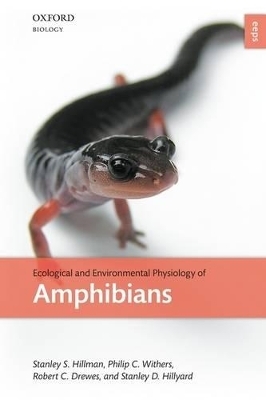
Ecological and Environmental Physiology of Amphibians
Oxford University Press (Verlag)
978-0-19-857032-5 (ISBN)
Amphibians are the extant descendants of the first vertebrate class to successfully colonize terrestrial environments; hence they occupy a unique position between fish and reptiles. Amphibian skin provides essentially no resistance to evaporative water loss, and consequently daily water turnover rates are an order of magnitude greater than in other terrestrial vertebrate groups. This has led to a suite of physiological, morphological and behavioural adaptations that have allowed a successful terrestrial existence in spite of this apparently spendthrift water retention strategy.
Ecological and Environmental Physiology of Amphibians provides a synthesis of current research on the comparative physiology of amphibians with a particular emphasis on water balance. It adopts a strong environmental perspective and includes a wealth of information on ecology, phylogeny and development. As with other books in the Ecological and Environmental Physiology Series, the emphasis in this book is on the unique physiological characteristics of the amphibians, although the latest experimental techniques and future research directions are also considered. This accessible text is suitable for both graduate students and researchers in the fields of amphibian comparative physiology and physiological ecology, including specialist courses in amphibian ecology. It will also be of value and use to the many professional herpetologists requiring a concise overview of the topic.
Stan Hillman is Professor and Chair of Biology at Portland State University. He obtained his Ph.D. in 1977 from the University of California, Los Angeles. He is the author of many papers on aspects of the osmotic, metabolic and cardiovascular physiology of amphibians from three continents. Philip Withers is Professor of Zoology at the University of Western Australia. He obtained his Ph.D. in 1976 from the University of California, Los Angeles. He is the author of over 200 publications on the physiology and ecology of vertebrates, and has extensive research experience with metabolic, osmotic and cardiovascular physiology of amphibians from four continents. He is the author of a textbook on Comparative Animal Physiology. Robert Drewes is Curator of Herpetology at the California Academy of Sciences. He obtained his Ph.D. in 1981 from the University of California, Los Angeles. He is the author of over 70 papers and two books on aspects of amphibian taxonomy, distributions and environmental physiology from species spanning three continents. He brings the taxonomic expertise so important in phylogenetic analyses of variation as well as an incredible field experience of the African amphibian fauna; he curates one of the largest museum collections of African amphibians and reptiles in the world. Stan Hillyard is Professor of Biology at the University of Nevada, Las Vegas. He ontained his Ph.D. in 1974 from the University of California, Riverside. He is the author of over 50 papers on aspects of the control of cutaneous water and ion absorption in amphibian skin. He has a unique background in the utilization of amphibians as model systems for general physiology, with a strong appreciation for grounding in environmental relevance. He also has extensive experience with researchers and the amphibian fauna of Europe.
1. Introduction ; 2. General Physiological Principles ; 3. Specialized Physiological Characteristics of Amphibia ; 4. Physiological Adaptations to Extreme Environments ; 5. Approaches and Techniques ; 6. Conclusions and Future Directions
| Erscheint lt. Verlag | 30.10.2008 |
|---|---|
| Reihe/Serie | Environmental & Ecological Physiology |
| Zusatzinfo | 105 line and 55 halftone illustrations |
| Verlagsort | Oxford |
| Sprache | englisch |
| Maße | 156 x 234 mm |
| Gewicht | 827 g |
| Themenwelt | Medizin / Pharmazie ► Medizinische Fachgebiete ► Arbeits- / Sozial- / Umweltmedizin |
| Naturwissenschaften ► Biologie ► Zoologie | |
| ISBN-10 | 0-19-857032-5 / 0198570325 |
| ISBN-13 | 978-0-19-857032-5 / 9780198570325 |
| Zustand | Neuware |
| Haben Sie eine Frage zum Produkt? |
aus dem Bereich


